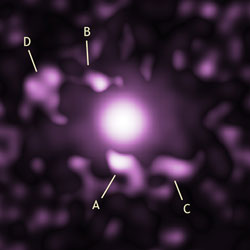NASA’s Chandra Finds Evidence for Quasar Ignition

Chandra X-ray Image of 4C37.43
New data from NASA’s Chandra X-ray Observatory may provide clues to how quasars “turn on.” Since the discovery of quasars over 40 years ago, astronomers have been trying to understand the conditions surrounding the birth of these immensely powerful objects.
Hot, X-ray producing regions around two distant quasars observed by Chandra are thought to have formed during their activation. These features are located tens of thousands of light years from the central supermassive black holes thought to power the quasars.
“The X-ray features are likely shock waves that could be a direct result of the turning on of the quasar about 4 billion years ago,” said Alan Stockton of the University of Hawaii in Honolulu, and lead author of a report on this work published recently in The Astrophysical Journal.
The quasars, 4C37.43 and 3C249.1, showed no evidence for the existence of a much larger envelope of hot gas around the features, nor were the observed X-ray regions associated with radio waves from the quasars. These factors rule out possible explanations for the X-ray emitting clouds, such as the cooling of hot intergalactic gas, or heating by high-energy jets from the quasars.
“The best explanation for our observations is that a burst of star formation, or the activation of the quasar itself, is driving an enormous amount of gas away from the quasar’s host galaxy at extremely high speeds,” said Hai Fu, a coauthor of the study who is also from the University of Hawaii.
Computer simulations of the formation of stars and the growth of black holes during a collision between two galaxies are consistent with this picture. The simulations, performed by Tiziana Di Matteo of Carnegie-Mellon University in Pittsburgh, Pennsylvania, and colleagues, show that the merger of galaxies drives gas toward the central regions where it triggers a burst of star formation and provides fuel for the growth of a central black hole.
The inflow of gas into the black hole releases a tremendous amount of energy, and a quasar is born. The power output of the quasar dwarfs that of the surrounding galaxy and expels gas from the galaxy in what has been termed a galactic superwind. The Chandra data provide the best evidence yet for a quasar-produced superwind.
Over a period of about 100 million years, the superwind will drive all the gas away from the central regions of the galaxy, quenching both star formation and further black hole growth. The quasar phase will end and the galaxy will settle down to a relatively quiet life. The tranquility of the galaxy will be interrupted from time to time as a small satellite galaxy is captured and provides food for the otherwise dormant supermassive black hole.
Other members of the research team were J. Patrick Henry, also of the University of Hawaii, and Gabriela Canalizo of the University of California, Riverside. NASA’s Marshall Space Flight Center, Huntsville, Ala., manages the Chandra program for the agency’s Science Mission Directorate. The Smithsonian Astrophysical Observatory provides science support and controls flight operations from the Chandra X-ray Center in Cambridge, Mass.
Media Contact
All latest news from the category: Physics and Astronomy
This area deals with the fundamental laws and building blocks of nature and how they interact, the properties and the behavior of matter, and research into space and time and their structures.
innovations-report provides in-depth reports and articles on subjects such as astrophysics, laser technologies, nuclear, quantum, particle and solid-state physics, nanotechnologies, planetary research and findings (Mars, Venus) and developments related to the Hubble Telescope.
Newest articles

Properties of new materials for microchips
… can now be measured well. Reseachers of Delft University of Technology demonstrated measuring performance properties of ultrathin silicon membranes. Making ever smaller and more powerful chips requires new ultrathin…

Floating solar’s potential
… to support sustainable development by addressing climate, water, and energy goals holistically. A new study published this week in Nature Energy raises the potential for floating solar photovoltaics (FPV)…

Skyrmions move at record speeds
… a step towards the computing of the future. An international research team led by scientists from the CNRS1 has discovered that the magnetic nanobubbles2 known as skyrmions can be…





















